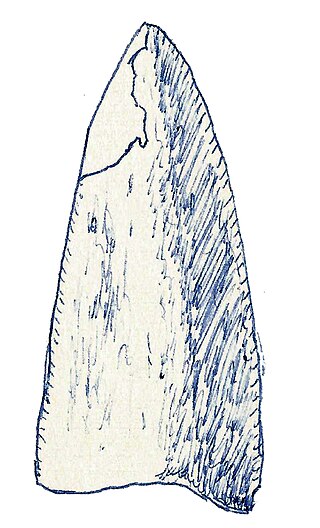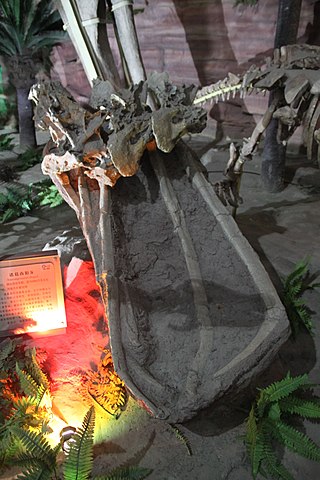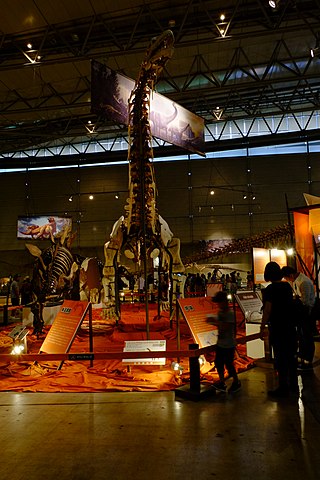
Antarctosaurus is a genus of titanosaurian sauropod dinosaur from the Late Cretaceous Period of what is now South America. The type species, Antarctosaurus wichmannianus, and a second species, Antarctosaurus giganteus, were described by prolific German paleontologist Friedrich von Huene in 1929. Three additional species of Antarctosaurus have been named since then but later studies have considered them dubious or unlikely to pertain to the genus.

Euhelopus is a genus of sauropod dinosaur that lived between 145 and 133 million years ago during the Berriasian and Valanginian stages of the Early Cretaceous in what is now Shandong Province in China. It was a large quadrupedal herbivore. Like sauropods such as brachiosaurs and titanosaurs, Euhelopus had longer forelegs than hind legs. This discovery was paleontologically significant because it represented the first dinosaur scientifically investigated from China: seen in 1913, rediscovered in 1922, and excavated in 1923 and studied by T'an during the same year. Unlike most sauropod specimens, it has a relatively complete skull.

Huabeisaurus was a genus of dinosaur from the Late Cretaceous. It was a sauropod which lived in what is present-day northern China. The type species, Huabeisaurus allocotus, was first described by Pang Qiqing and Cheng Zhengwu in 2000. Huabeisaurus is known from numerous remains found in the 1990s, which include teeth, partial limbs and vertebrae. Due to its relative completeness, Huabeisaurus represents a significant taxon for understanding sauropod evolution in Asia. Huabeisaurus comes from Kangdailiang and Houyu, Zhaojiagou Town, Tianzhen County, Shanxi province, China. The holotype was found in the unnamed upper member of the Huiquanpu Formation, which is Late Cretaceous (?Cenomanian–?Campanian) in age based on ostracods, charophytes, and fission-track dating.

Sonorasaurus is a genus of brachiosaurid dinosaur from the Early to Late Cretaceous. It was a herbivorous sauropod whose fossils have been found in southern Arizona in the United States. Its name, which means "Sonora lizard", comes from the Sonora River that flows in the Sonoran Desert where its fossils were first found. The type species is S. thompsoni, described by Ratkevich in 1998.
Gobititan is a genus of herbivorous sauropod dinosaur from the Aptian faunal stage of the Early Cretaceous. The name of this genus is derived from the Gobi desert region and the Titans of Greek mythology, which is a reference to its large body size. The specific name shenzhouensis, is derived from "Shenzhou", an ancient name for China.

Mongolosaurus is a genus of titanosauriform sauropod dinosaur which lived during the Early Cretaceous of China.

Jiangshanosaurus is a genus of herbivorous titanosauriform sauropod dinosaur that lived in China approximately 92-88 million years ago, during the Turonian-Coniacian stage of the Late Cretaceous.

Phuwiangosaurus is a genus of titanosaur dinosaur from the Early Cretaceous (Valanginian-Hauterivian) Sao Khua Formation of Thailand. The type species, P. sirindhornae, was described by Martin, Buffetaut, and Suteethorn in a 1993 press release and was formally named in 1994. The species was named to honor Princess Maha Chakri Sirindhorn of Thailand, who was interested in the geology and palaeontology of Thailand, while the genus was named after the Phu Wiang area, where the fossil was discovered.
Fusuisaurus is a genus of sauropod dinosaur from the Early Cretaceous of China. Fragmentary postcranial remains of this animal have been discovered in 2001 in the Napai Formation of Guangxi, China and consist of the left ilium, left pubis, anterior caudals, most of the dorsal ribs and distal end of the left femur. This sauropod has been described as a basal titanosauriform.

Dongyangosaurus is a genus of titanosaurian sauropod dinosaur from the Late Cretaceous. The only species is Dongyangosaurus sinensis, from which only a single fragmentary skeleton is known, coming from the Zhejiang province of eastern China. It was described and named by Lü Junchang and colleagues. Like other sauropods, Dongyangosaurus would have been a large quadrupedal herbivore.
The Hekou Group is a geological group in Gansu Province, China. It is Early Cretaceous in age. Many dinosaur fossils have been recovered from the Hekou Group, including iguanodonts, large sauropods, and armored dinosaurs. Fossil eggs are rare, but one oogenus, Polyclonoolithus, was discovered in the Hekou Group. Extensive fossil tracks belonging to pterosaurs and dinosaurs have also been described. The group spans the Valanginian to Albian and can be subdivided into four formations.

Ruyangosaurus is a genus of titanosauriform sauropod dinosaur recovered from the Early Cretaceous Haoling Formation of China. The type species is R. giganteus, described in 2009 by Lü Junchang et al.

Baotianmansaurus is a genus of titanosaur sauropod dinosaur. Its fossils have been found in Upper Cretaceous rocks in Henan, China, within the Gaogou Formation. The type species is B. henanensis, described in 2009. The holotype is 41H III-0200. Remains of the fossils were vertebrae, ribs and scapula fragments. It was probably a close relative of Opisthocoelicaudia and Dongyangosaurus in Saltasauridae.

Wintonotitan is a genus of titanosauriform dinosaur from Cenomanian -age Winton Formation of Australia. It is known from partial postcranial remains.

Xianshanosaurus is a genus of sauropod dinosaur from the Early Cretaceous (Aptian-Albian) of the Ruyang Basin in Henan Province, China. Its type and only species is Xianshanosaurus shijiagouensis. It was described in 2009 by a team of paleontologists led by Lü Junchang. Xianshanosaurus may be a titanosaur, and Daxiatitan may be its closest relative, but its evolutionary relationships remain controversial.
Yunmenglong is an extinct genus of somphospondylan sauropod known from the late Early Cretaceous of Henan Province, central China. Its remains were discovered in the Haoling Formation of the Ruyang Basin. The type species is Yunmenglong ruyangensis, described in 2013 by Junchang Lü et al. on the basis of an incomplete postcranial skeleton. Yunmenglong shares some characters with Euhelopus, Qiaowanlong and Erketu, and a phylogenetic analysis places it as a sister taxon of Qiaowanlong, both grouped with Erketu in a position more derived than Euhelopus but basal to Titanosauria.

Yongjinglong is an extinct genus of titanosauriform sauropod dinosaur known from the Early Cretaceous of Lanzhou-Minhe Basin of Gansu Province, China. It contains a single species, Yongjinglong datangi.

Sibirotitan is a genus of somphospondyl sauropod from the Ilek Formation of Russia. The type and only species is S. astrosacralis.

Dzharatitanis is a genus of sauropod from the Bissekty Formation in Uzbekistan, dating to the Turonian age of the Late Cretaceous. The genus contains a single species, Dzharatitanis kingi, named after geologist Christopher King, who contributed to the Cretaceous geology of Asia. It is currently one of two known sauropods from the Bissekty Formation, alongside an indeterminate titanosaur. In its original publication it was considered to be a member of Rebbachisauridae, but later papers considered it to be a titanosaur.































